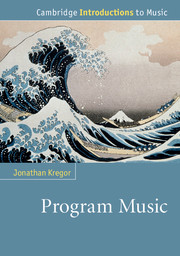Book contents
- Frontmatter
- Contents
- List of Figures
- List of Music examples
- List of Tables
- Acknowledgments
- Note on the text
- Introduction
- Chapter 1 Characters, topics, and the programmatic battlefield
- Chapter 2 Expression, musical painting, and the concert overture
- Chapter 3 Berlioz and Schumann on music and literature
- Chapter 4 Liszt and the symphonic poem
- Chapter 5 The New German School and beyond
- Chapter 6 Excursus: Faust
- Chapter 7 Programmatic paths around the fin de siècle: Mahler and Strauss
- Chapter 8 Programming the nation
- Chapter 9 “Ars Gallica”
- Notes
- Guide to further reading
- Index
Chapter 2 - Expression, musical painting, and the concert overture
Published online by Cambridge University Press: 05 January 2015
- Frontmatter
- Contents
- List of Figures
- List of Music examples
- List of Tables
- Acknowledgments
- Note on the text
- Introduction
- Chapter 1 Characters, topics, and the programmatic battlefield
- Chapter 2 Expression, musical painting, and the concert overture
- Chapter 3 Berlioz and Schumann on music and literature
- Chapter 4 Liszt and the symphonic poem
- Chapter 5 The New German School and beyond
- Chapter 6 Excursus: Faust
- Chapter 7 Programmatic paths around the fin de siècle: Mahler and Strauss
- Chapter 8 Programming the nation
- Chapter 9 “Ars Gallica”
- Notes
- Guide to further reading
- Index
Summary
Given that many of the expressive devices found in instrumental music in the second half of the eighteenth century were first tested and approved on the operatic stage, it was natural that the opera overture soon became one of the main sites for significant programmatic innovation. In the famous preface to the printed score of his “reform opera,” Alceste, from 1769, Christoph Willibald Gluck stressed how “the overture ought to apprise the spectators of the nature of the action that is to be represented and to form, so to speak, its argument.” Writing over seventy years later, Richard Wagner pinpointed the aesthetic difference between the sectional, mono-expressive overture before Gluck, and those that subsequently “weld[ed] the isolated sections to a single undivided whole, whose movement [was] sustained by just the contrast of those different characteristic motives.” Accordingly, outstanding examples of the poly-characteristic opera overture resolved “the conflict between [opposing] musical themes in a manner analogous to the resolution of the drama in question.” Yet the most outstanding overtures went even further, Wagner argues, by shedding the claustrophobic mandate to analogously reenact and resolve the upcoming stage work in favor of creating self-sustaining, independent instrumental dramas. And while he singled out notable examples in the history of the opera overture’s development since Gluck – including W. A. Mozart, Luigi Cherubini, and Carl Maria von Weber – for Wagner the epitome of the dramatic overture was Ludwig van Beethoven, whose concert overtures not only heavily influenced the composition of the overtures or preludes to Wagner’s own operas from the period, such as Der fliegende Holländer, Tannhäuser, and Lohengrin, but also the single-movement dramatic or poetic overtures of Beethoven’s contemporaries.
- Type
- Chapter
- Information
- Program Music , pp. 39 - 68Publisher: Cambridge University PressPrint publication year: 2015



